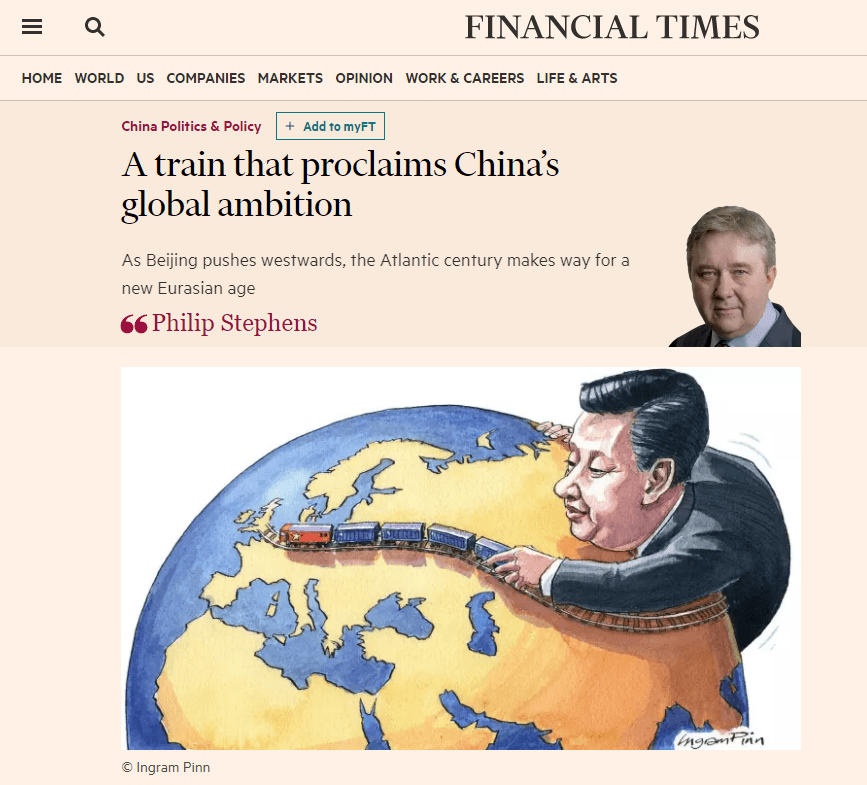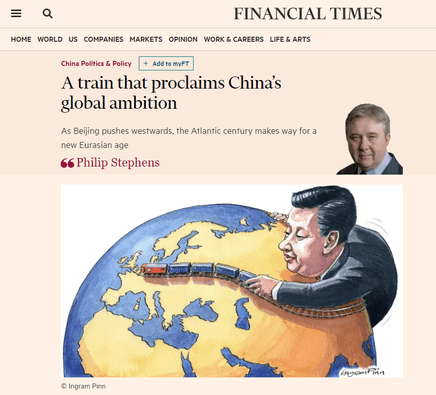Blog | 21 Jul 2017
‘A train that proclaims China’s global ambition’ – strengths and weaknesses of Philip Stephens Financial Times analysis of China’s ‘One Belt One Road’

Stephens specifically notes the considerable underestimation of B&R in much of the Western media: ‘Among this year’s under-reported events was the opening of a new rail freight route. A locomotive, pulling wagons loaded with Chinese manufactures, set out in early January from Yiwu in Zhejiang province. Some 18 days and seven countries later it arrived at a goods depot almost 7,500 miles away on the eastern edge of London.’
If correction of underestimation of B&R in the Western media is the very substantial strength of Stephens article its weakness is underestimation of the economics of B&R, and therefore a resulting tendency to see it in too geopolitical terms – in the worst case, citing Zbigniew Brzezinski, as almost a ‘geopolitical conspiracy’. Stephens write: ‘The jury is out on the economics of this latest reincarnation of the ancient silk routes. That is beside the point. The journey above all else was a statement of China’s geopolitical intent.’
He notes: ‘Zbigniew Brzezinski, the former national security adviser to president Jimmy Carter who until his death this year was Washington’s sharpest strategic thinker, long ago grasped the significance of what he called the “axial supercontinent”. “A power that dominated Eurasia”, he wrote as far back as 1997, “would exercise decisive influence over two of the world’s three most economically productive regions, western Europe and East Asia . . .”… As the US retreats, China makes its presence felt. Quite suddenly, the Eurasian century has a certain ring to it.’
The weakness of Stephens analysis, which gives rise to the implication that B&R is really simply, or overwhelmingly, only about geopolitics is (implicit) underestimation of the economics involved.
The B&R region is now by far the most powerful locomotive not only of the regional but of the global economy.
- Measured at current exchange rates the IMF projects that in the next five years growth in the B&R region measured in absolute dollar terms will be almost twice that in North America and four times that in Europe.
- Measured in purchasing power parities (PPP’s) growth in the B&R region will be almost five times that in North America and more than five times that in Europe.
Growth in the B&R region, in summary, will dwarf that in North America and Europe.
Measured at current exchange rates projections from IMF data from 2016-2021 shows that in the next five years the B&R region will account for 46% of world economic growth – compared to 24% for North America and 10% for the European Union.
As the average growth rates in countries in the B&R region are much faster than those in either North America or the EU within five years the structure of the world economy will be sharply changed. By 2021 the GDP of the B&R region, calculated from IMF data, will be $29.7 trillion, compared to $21.1 trillion for North America and $18.3 trillion for the EU. In percentage terms the B&R region will be 31.3% of world GDP – compared to 27.3% for North America and 19.2% for the EU.
Philip Stephens article is therefore noteworthy as indicating a Western analysis by a leading journalist in a major Western publication which fully understands the impact of B&R. Further dialogue with Chinese economists will be valuable as they can help correct one-sidedness’s which remain.


